Mastering Agency Management for Higher Profits
With expert contribution from:
Launching an agency is simple. Keeping it profitable is where it gets real.
What trips up most agency owners isn’t the lack of clients; it’s the avalanche of operations that comes after. Resource planning, capacity management, delivery margins, project profitability … all the behind-the-scenes stuff that quietly determines whether your business thrives or just survives.
The average digital agency nets only 15% profit. But the agency owners we spoke to? They’re running at 30-40% margins without burning out their teams or themselves.
This playbook pulls back the curtain on how successful agencies maximize profitability and demonstrates how to replicate their approaches.
Popular agency
profit models
explained
A profit model is your agency’s blueprint for making money. It outlines how you’ll generate revenue, manage costs, and ultimately, turn a profit. Without a clear model, agencies risk running on luck rather than strategy.
Eli Rubel, two-time founder and owner of agencies Matter Made and NoBoringDesign says,
But how do you choose the right model for your agency? Here’s an overview of the top options.
Hourly billing
As it says on the tin, hourly billing means charging clients for time spent on a task or project. Agencies either estimate hours upfront for standard project scopes or send a client invoice later based on accumulated billable hours.
Hourly billing works for:
- Consultancy businesses
- Legal firms
- Development agencies
- Accounting firms
- Financial advisors
The downside? Hourly billing caps your earning potential. The only way to grow your agency is to log more hours or increase hourly rates. Neither is infinitely scalable.
Hourly billing may also cause client friction, especially if they question time logs or nickel-and-diming every call. Plus, this profit model incentivizes time spent, not outcomes delivered — which can mismatch value-driven work. Quoting successful consultant Alan Weiss,
An obsession with clocking the most billable hours can also create unhealthy staff dynamics. In accounting firms, it leads to constant overtime and subsequent employee burnout, which is bad news for business.
Still, hourly billing remains one of the most-used agency pricing models because of its undeniable perks: easier project cost estimation, transparent client reporting, and adaptability for shifting scopes.
Fixed-price model
A fixed-priced (or project-based) model means you charge a flat rate for a scoped block of work or an itemized list of deliverables — no surprises. It works particularly well for projects with solid briefs and specific requirements, like website development packages, SEO audits, or video campaign production.
Brooklin Nash, founder of Beam Content, also prefers this pricing model. He explains,
This way, clients benefit from predictability, while agencies optimize their profit margins by improving workflow management efficiency.
Fixed pricing works for:
- Branding and marketing agencies
- Website design and development studios
- UX/UI design projects
- Email marketing agencies
- Photography or videography businesses
Yet, fixed pricing can backfire with scope creep or unclear deliverables. You risk undercharging for complex work or absorbing unexpected costs if timelines stretch. Fixed-price models require tight scoping and airtight contracts. Nash, for example, has clauses stipulating that monthly payments won’t change if there are client-side delays.
Retainers
The retainer model hits the sweet spot between fixed pricing and hourly billing — clients pay a set monthly fee for ongoing access to your services. Agencies receive predictable revenue, while clients get peace of mind that you're on call.
Retainers are a good fit when you’re part of a client’s long-term strategy, providing steady output rather than one-off assistance.
Retainers work for:
- Managed services providers
- Content creation studios
- Social media marketing agencies
- PR and communication firms
- Technology implementation partners
Grey Matter, a B2B performance marketing agency, uses retainers for 90% of its projects. According to Managing Director Tony Bradberry, the retainer pricing is based on the typical hours spent on each client project, which Bradberry can estimate precisely thanks to time tracking tools and repeatable agency workflows.
“Selling to a client before fully understanding their problems and what drives growth is difficult. So we switched from preset scope-based retainers to an hourly retainer model,” Bradberry explains.
Project time tracking has also shed light on some revenue trends. Bradberry says they sometimes overserviced clients and, in other cases, did not invest enough effort for the best results. Time insights helped Bradberry adjust service scopes and improve client relationships without sacrificing profitability.
The flip side of retainers is fuzzy expectations. Without a clear list of deliverables or usage boundaries, clients may expect unlimited work, while your team risks getting stretched thin.
It also requires proactive client management. If a client doesn’t fully understand the service model, they may question the value and churn. “When onboarding new clients, we don’t send classical proposals. Instead, we’ll send a capability statement. It explains how our agency operates, how the teams are built, and how the retainers work,” adds Bradberry. This ensures the right client fit and retains key accounts.
TL;DR: Expectation management, time tracking, and regular check-ins are key to keeping retainers working for you.
Productized services
Productized services structure your expertise into pre-packaged, repeatable offerings with a set scope, timeline, and price — think of it as the agency version of “add to cart.”
It’s another spin on the fixed-pricing model but with a greater emphasis on scope control and repeated steps (i.e., you can really do the same thing for pretty much the same number of hours to keep a good profit margin).
Productized services work for:
- Podcast or webinar editing
- Monthly content bundles
- SEO services
- Website management
- Customer support
The obvious downside is there’s not much room for nuance. If a client needs something just outside the box, you either say no (and risk losing new business) or bend the rules (and tamper with margins).
Generally, this service model works best for low(er) ticket offerings when clients know well what they want.
Performance-based pricing
Performance-based pricing links your earnings to delivered client results. Whether it’s leads, conversions, clicks, or revenue, compensation is directly tied to agreed-upon performance metrics.
For clients, the appeal is strong: You pay for proven value, not vague promises. Similarly, agencies confident in their craft can increase an average customer bill by profiting from every outcome.
When paired with a performance-based pay structure for staff, the results can be pretty strong.
Noel Land, an Account Development Manager at Convertros, says,
Perfomance-based pricing works for:
- PPC agencies
- Affiliate marketers
- Lead generation agencies
- Media buying agencies
- Outbound sales agencies
On the other hand, you’re also carrying more risk. You can’t influence all client-side factors (e.g., lack of stakeholder engagement or delayed decision-making), which may sabotage performance. You’ll also need advanced analytics apps to track and attribute all performance results. While the upside of performance-based pricing can be big, so is the gamble.
Value-based pricing
Value-based pricing means you charge based on the perceived value of the outcomes you’ll deliver.
Similar to performance-based pricing, you still have skin in the game but a bit more risk because you set the price before the work begins based on expected ROI or impact. Effectively, value-based pricing is a fixed price, but it's not directly linked to hours, deliverables, or actual results. Instead, it's anchored in likely future outcomes.
When explaining pricing at Grey Matter, Tony Bradberry likes to leverage the ‘value’ card. He says,
Instead, Bradberry sells them on the value of possible results from different tactics and playbooks, each priced separately.
That's why the toolbox really works, because it's less about what they think we should be doing and more about the outcomes that they're desiring.”Watch the full interview with Tony here
Value-based pricing works for:
- Performance marketing agencies
- Conversion rate optimization firms
- Business strategy consultants
- Branding agencies
- Digital transformation agencies
That said, value-based pricing doesn’t always sway clients. To pull it off, you’ll need compelling case studies, polished positioning, and a reputation of being an agency that delivers. Plus, not every service lends itself to easy ROI attribution, making the model tricky to justify or scale.

Pro tip: A profit model isn’t set in stone
You don’t have to commit to one profit model. Most agencies use a mix of several to better reflect the nature (and value) of different service lines. Likewise, it’s not a set-it-and-forget setup. Market dynamics shift, and customer relationships wane. So, you need to stay flexible.
“On one hand, I can't plug every market variable spreadsheet to predict future profitability with certainty,” says Eli Rubel. “What I can do, though, is constantly seek new ways to fine-tune and tweak the agency profit model.” This iterative approach to agency management optimization has allowed Rubel to maintain 40%+ net margins at both of his companies.
What factors affect agency profitability?
Under the hood, a profit model is a collection of parameters you can tweak to increase (or, well, decrease) your profitability. Most of them relate to your operations — how you scope work, allocate resources, and manage delivery. But some are external, too, such as new regulations or labor shortages.
Here’s a table summing up the key drivers of agency profitability:
- % of billable vs non-billable hours
- Time wasted on admin
- Clear vs. chaotic workflows
- Resource utilization rate
- Over-servicing low-margin clients
- Poor capacity planning
- Acquisition costs
- Retention rates
- Per client profitability
- Price structure
- Billing accuracy
- Discount strategy
- Scope management
- Resource allocation
- Project budgeting
- Time-to-hire
- Employee turnover
- Team productivity
- Degree of process automation
- Data analytics adoption rate
- Client reporting automation
- Regulatory changes
- Tax rate hikes
- New competitors
Agency owners’ advice
for optimizing agency profit margins
Effective agency management isn’t about working harder — it’s about working smarter behind the scenes.
Agency owners who’ve mastered their margins know the biggest gains come from using data to optimize capacity planning, streamlining service delivery, and making tough but intentional choices about service and client portfolios.
We asked seasoned founders to share strategies that turned their chaotic calendars into consistent profits. Here’s their best advice for running leaner, smarter, and more profitable agencies.
Implement time tracking
Agency owners often underestimate the value of time tracking. Tony Bradberry recounts:
Like many digital agencies, Grey Matter has its share of bad clients — those who struggle to convey their needs, aren’t great at communication, and cause project delays. “When we started tracking time in our second year, we discovered that while the upfront revenue looked great on some accounts, the actual time waste and drag on the agency as a whole was huge,” Bradberry admits.
To cut that slack, Tony ran time studies of every workflow to map the expected duration. With a reference time benchmark, the Grey Matter team improved capacity planning. “When we plan the 90 days of work for each client, we use our time data and their retainer hours. Then, like in the old Apollo 13 movie, we think how we can fit everything and get someone home safely from the moon,” he jokes.
For Grey Matter, time data was key to optimizing the capacity-to-contract fit for each client, avoiding over-servicing, and maintaining a higher profit margin.
Copy this Strategy
Know which actions pay off
With Toggl Track, you can run a multi-level profitability analysis across projects, clients, tasks, or users to determine which actions bring (or siphon away) revenue.
With forecasts backed by time data, you can improve your financial management, pricing, staffing, and project budgeting decisions.

Anchor hiring decisions in utilization rates
Running a successful agency is a balancing act of optimized capacity levels vs. workload levels. When you’re over-staffed, profit dips due to high payroll costs. But with too few staff and new accounts rolling in, work quality and team morale decline.
To avoid such scenarios, Eli Rubel constantly monitors the resource utilization rate.
Better resource visibility helped Rubel improve its recruitment process, which he didn’t take seriously early on and now regrets. “We relied on external recruiters or wing it and scoured LinkedIn ourselves. But upon reflection, I realized that things stressing me out both personally and as a business were hiring related,” he says.
Rubel replaced the ad hoc recruitment approach with an internal HR Center of Excellence, which he called “a game changer.” The new Head of Talent Acquisition set up an effective talent pipeline, activated when the utilization rate enters the dangerous zone.
With a data-driven approach to hiring and resource allocation, Rubel can shift his attention to where it’s needed. He admits that one of his agencies runs at a 60% utilization rate, meaning 40% of available work hours are unused. So, sales and account managers need to double down on new business development.
Copy this Strategy
Speed up talent acquisition
With dynamic demand, many agencies need extra talent for yesterday. Use hiring tools to build fast, data-driven hiring pipelines in several clicks from pre-made templates (and customize as needed).
Centralize all hiring-related messaging to improve cross-team collaboration. Verify the candidate’s real-world capabilities with integrated skill tests to avoid mis-hires. Remove repetitive tasks from your hiring cycle with smart automation tools to shortlist and hire the best talents fast.
Hire fractionally to balance resource utilization
Poor visibility into workload and uncertain client demand can undermine cash flow. But hiring more in-house staff can be cost-inhibitive or too risky if you’re still testing the waters. Most agencies also can’t afford to bring in the wrong people due to the high costs of bad hires.
That’s why Tom Whatley, CEO at B2B content marketing agency Grizzle, advocates for bringing in fractional people instead. He says,
Whatley reduced hiring risks by bringing in people who already deeply understood the company’s inner workings. For freelancers turned full-timers, Grizzle’s culture was a strong attractor. “Our culture protects the lifestyle people want as a freelancer, but they also get better job security and learn a lot.”
Grizzle is now testing a new service line — video marketing — and once again, Whatley is hiring fractional first. “I had someone in my network who excelled in video. He’s now embedded in our team, building the client delivery processes and doing the work itself. We’ll soon need a producer, maybe a videographer, and voice-over artists. Because the offer is still emerging, hiring fractional for all video-related roles means lower risks for us.”
When the client offering is validated, Whatley expects to bring some of his fractional hires in-house for leadership roles, which is a win-win for both sides. “Generally, I’m a big fan of building out a bench of people that you need before you need them and then hiring them in-house once there’s proven client demand,” he adds.
Speed up workflows with an agency management system
(In)effective project management is another major component of agency profitability. If your bright people get bogged down in repetitive tasks and endless admin, you’re losing money.
Unfortunately, low operational efficiency is a common theme, not just among agency owners. Globally, only 21% think their operating model is running at optimum. Why so?
- Manual and/or fragmented business processes
- Data and communication silos across teams
- Lack of proven insights for decision-making
The better news? You can fix most of these issues with a better agency management solution (AMS) — purpose-built software for managing the Ops side of the business. Typical functionality includes project scheduling, task management, capacity planning, contract management, invoicing, workflow automation, and all sorts of real-time analytics.
AMS helps improve team productivity through better goal alignment, task prioritization, and workload visibility. It keeps clients accountable, too. “We have a Client View in our project management tool,” shares Brooklin Nash. “Every client has a milestone view for specific dates for general accountability. They can also see and act on all action items assigned to them.”
Dedicated client dashboards replaced constant back-and-forth emails as clients can easily see project progression via a Gantt chart, review editorial calendars, and give feedback. This reduces client anxiety, builds trust, and makes everyone feel involved in the process.
Copy this Strategy
Improve your operations with analytics
Get a better view of your agency's needs with Toggl Track Project Dashboards. Predict project completion based on tracked hours and project estimates to ensure optimal resource allocation and manage client expectations. Track billable vs non-billable hours distribution to better understand where inefficiencies happen.
For better execution, use visual project management tools informed by time-tracking data to optimize your team's capacity and task scheduling with time insights. This helps avoid missed deadlines, overwork, and scheduling conflicts. You can also easily involve clients in the project life cycle by sharing visual timelines and giving automatic updates on completed milestones.
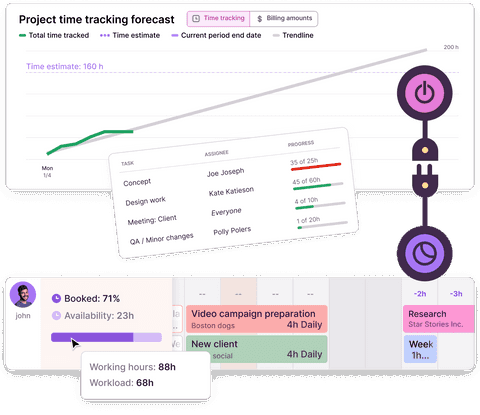
Involve your teams in client relationship management
Effective client retention leads to steady, scalable profit. But keeping those relationships warm can be tough when your team juggles 30+ accounts. Heavy reliance on account managers to constantly check in with the core team on project statuses, client KPIs, and other updates also creates communication lag.
To avoid such scenarios, Tony Bradberry involves all teams in client communication. He explains,
During client onboarding, Bradberry introduces the assigned team to the client and lets them take over the relationship. “Because our teams set the strategy, it’s their job to convince the client they need extras for success, like more hours in their retainers or a HubSpot implementation,” Bradberry adds.
Direct involvement allows marketing teams to build stronger client rapport. They can show off their chops before pushing for a bigger project (and a bigger retainer), which may be harder for a client to justify. By pitching need-based upsells, teams can drive more revenue, cut acquisition costs, and deepen client loyalty.
It also allows for greater scalability in client relationship management. As an agency owner, you don’t need to play the middleman and can focus instead on more value-added work.
Copy this Strategy
Strengthen customer trust with data
Besides increasing your team’s ‘face time’ with clients, you can also build better client rapport via operational insights.
Try Toggl Track to create custom reports tailored to a client's needs in a few clicks. Share data about accrued billable hours or progression rates broken down across different projects and tasks. With flexible charts and filters, you can create shareable reports that showcase data exactly how your clients want to see it — clear, goal-driven, and on point.
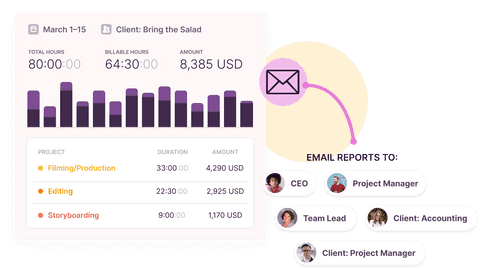
Periodically prune your service and client list
Since profit margins are directly related to revenue, many agency owners strive for revenue at all costs. They go after more clients, launch extra services, and otherwise hustle to keep that number up.
But without visibility into the other side of the profit equation — the cost of doing business — you’re not seeing the full story. Your revenue may be going up, but your profit margins are not because you’re burning too many resources to keep up with unsustainable demand.
Around that time, Grizzle also tried to venture out of its SaaS B2B niche. They onboarded an e-commerce client and considered expansion in that space. But that step didn’t pan out because the agency lacked the resources to penetrate the market.
The events made Whatley rethink his approach to service portfolio expansion. “We still want to try new services, but we now trial them for ourselves first,” he says. Before launching a client-facing video marketing service, Whatley worked on the agency’s YouTube channel to evaluate the benefits and trial their operating workflows. This slower but more data-driven strategy to service development has avoided Grizzle some costly losses.
Tony Bradberry of Grey Matter shares a similar vision regarding the client list. Like Whatley, he’s no longer afraid to reverse decisions to protect profit margins, namely, phasing out unprofitable clients. He shares,
The decision felt scary at first, but it was the right call. After parting ways with unprofitable accounts, Grey Matter ended up with a more manageable workload and a higher profit margin.
The lesson? Don’t hesitate to sunset unprofitable services, raise rates, or drop low-value clients if your goal is to increase agency profitability rather than revenues alone.
Copy this Strategy
Streamline profitability tracking
Toggl Track offers multiple ‘lengths’ for monitoring agency profitability. Assign custom billing rates for different tasks, teams, clients, and team members.
After logging hours, you can track and forecast revenue per client or project via the Billing amount report, which tracks financial progress against fixed costs. Or, run a revenue-based workload analysis to identify high-value activities and top revenue contributors. With these insights, you can easily spot (and prune) unprofitable service lines or client accounts to strengthen your margins.
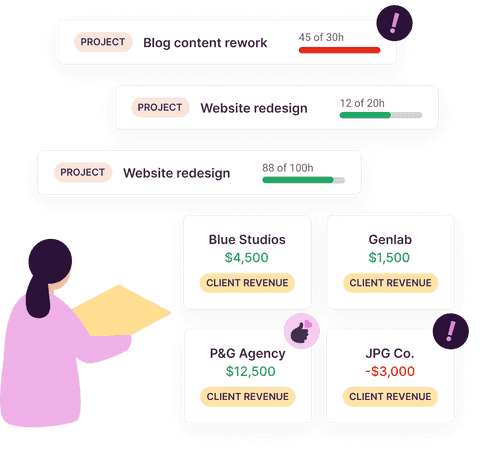
Learn to move with the flow
The ‘feast and famine’ cycle is common for early-stage agencies. One month, you’re onboarding several large accounts. The next, clients slash their budgets or cancel retainers. Unlike product businesses, agencies rely heavily on people and billable hours, making scaling more complex and resource-dependent.
... recounts Eli Rubel, who spent millions on recruiting fees to fix this.
But when the market changed again, and demand dipped, Rubel was better prepared. His Profit Systems dashboard lets him estimate how key metrics — revenue, OpEX, and margins — will look with any number of customers or employees, allowing him to “scale responsibly.”
No one can predict market shifts, but you can inform your growth strategy with data like:
- Historical billing and cash flow trends
- Time insights about project timelines
- Resource utilization rate
- Client retention and churn rates
- Billable vs non-billable time ratios
- Team capacity vs. actual workload
- Budget vs actual performance per project
- Average project profitability by service type
- Seasonality patterns in workload or revenue
Prepare for the short-term future by avoiding scenarios where demand outpaces hiring, or low-value projects siphon away resources from high-ticket items. Knowing where you stand helps you adapt to challenges and maintain a cushion for slower periods.
Build your agency management HQ in Toggl
Profitability doesn’t just happen — it’s built. And to build it, you need visibility into the numbers that actually move your margins.
Toggl's suite of tools help you take control of every stage of agency management — from scoping and staffing to delivery.

Start by tracking the right metrics
Before you optimize, establish your profit baseline. Toggl Track gives you the data foundation you need by combining time entries, billable hours, and project costs with profit-focused reporting. Try out our tool to capture key metrics like:
- Gross and net profit margin
- Revenue per employee (RPE)
- Delivery margin
- Billable utilization rate
- Non-billable time ratio
- Average project value
- Client profitability
Use these numbers to set performance benchmarks by service type or project scope — and track progress toward profit targets using the Profitability Analysis report view in Toggl Track.

Optimize allocation, timelines, and team capacity
Once you’ve got your benchmarks, it’s time to focus on your agency operations. Use project planning tools to:
- Visualize team workloads across all projects
- Track capacity and utilization to avoid over/understaffing
- Align timelines and resourcing with client deadlines
- Get predictive insights into project completion rate and budget usage
Thanks to a native integration with Toggl Track, use employee time data to inform your planning. Make more confident resourcing decisions, reducing burnout, missed deadlines, and unbilled overtime.
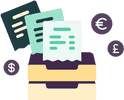
Streamline expenses, benefits & invoicing
Once your ops are humming, tidy up the money side. Use Toggl Work to keep every expense and benefit in one place and move from receipt → approval → invoice without the admin drag. Use Toggl Work to:
- Auto-scan receipts with AI to extract key details and kick off approvals
- Speed up approvals with rules for auto-approve or one-click manager review
- Invoice faster by pushing approved expenses straight onto invoices
- Handle multi-currency expenses for trips and perks across regions
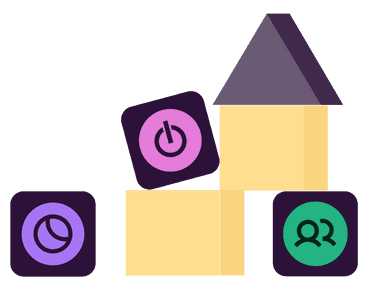

The part you’ll love most?
You can try all Toggl products for free to see where you’re losing time, money, or momentum (and find ways to fix it!) Speak to sales to book a demo and start your free product trials today.










